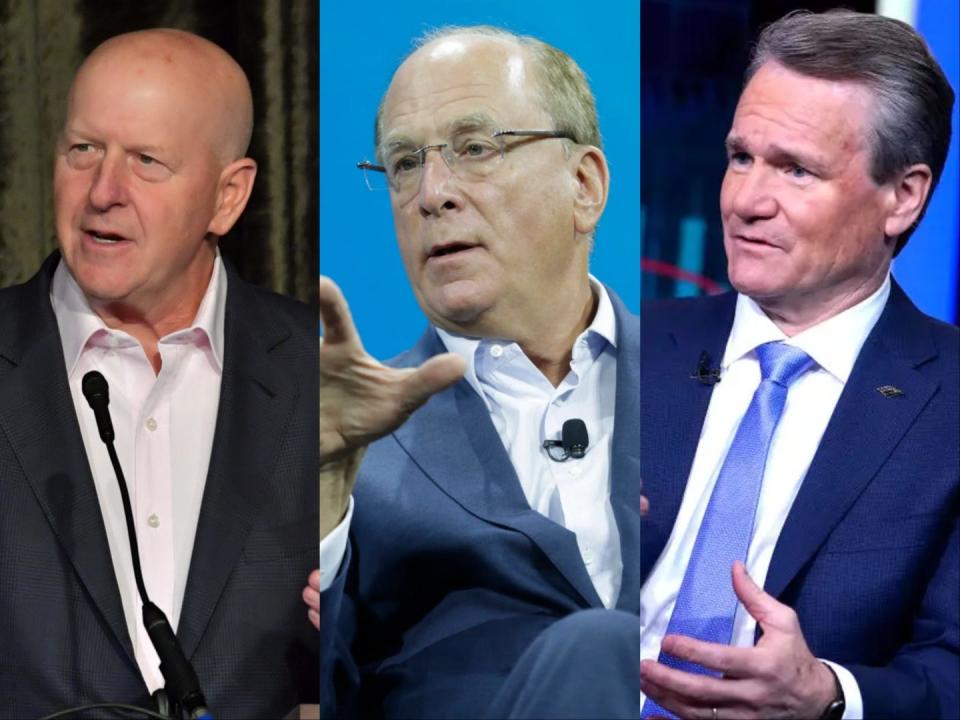.
The biggest challenge facing Wall Street's mat execs this spring: keeping two jobs.

-
Goldman Sachs, BlackRock and Bank of America are all facing similar shareholder proposals this year.
-
Some investors want to split the dual roles of chief executive and chairman so that one person does not have all the power.
-
Even if these proposals are successful, researchers are skeptical that spin-offs will make companies better.
This spring, three of Wall Street's top bosses were facing investor dissatisfaction with their work.
Investors in Goldman Sachs, BlackRock and Bank of America proposed in this year's shareholder proposal to separate David Solomon, Larry Fink and Brian Moynihan from their roles as chief executive officer and chairman, respectively. Separation of the positions of Chief Executive Officer and Chairman of the Board of Directors of David Solomon, Larry Fink and Brian Moynihan, respectively. The attempt to add more independent oversight to the Company's Board of Directors is an open rebuke to these mat executives.
Proxy advisory firms, which advise major shareholders on how to vote, often want different people to serve as chief executive officer and board chair to minimize perceived conflicts of interest. Last week, top proxy firms Glass Lewis and Institutional Shareholder Services suggested that Goldman Sachs and Bank of America split the positions of chief executive and board matron. A British activist fund is pushing BlackRock, the world's largest asset manager, to do the same.
In their annual meeting materials, Goldman Sachs, BlackRock and BofA urged investors to vote against the change.
Splitting the cyclical history of the roles of mat executives and chairpersons
These proposals come and go, and Wall Street has seen many similar ballot questions from shareholders large and small. Most proposals are defeated or result in short-term changes.
For example, in 2009, under pressure from shareholders, Bank of America separated the positions of chief executive officer and chairman of the board, only to have Moynihan reorganize the position five years later. The bank is once again facing a shareholder proposal to separate Moynihan's roles, in the same way that a similar vote failed in 2015.
According to data provider ISS-Corporate, nearly 14% of S&P 500 companies received shareholder proposals to separate the roles of chief executive officer and chairman last year, up from 6% in 2021, and the average support for these proposals was about 30%. BlackRock supported such a proposal at Exxon in 2020, but it ultimately failed. (BlackRock supported such a proposal at Exxon in 2020, but it ultimately failed.
Over the past few decades, U.S. companies have increasingly separated jobs. But researchers at Stanford University's Graduate School of Business wrote in a 2016 paper that role separation has "竝o not have a clear positive effect" on corporate performance.
Researchers at Stanford University tracked board changes at the 100 largest and 100 smallest public companies over a 20-year period ending in 2016. They found that during that 20-year period, one-third of the companies, including Bank of America, separated the roles of chairman and chief executive officer, and later carries the name.
Large companies - such as the current Wall Street Big Three - are more often the target of shareholder proposals to create spin-offs than small companies. In the past 20 years, 56 of the 92 large companies have faced at least one shareholder proposal to create an independent chairman. Of the 95 smaller companies, only three have.
"This suggests that the target companies for which shareholders advocate for independent board leadership may not necessarily be those with the most serious governance problems, but rather those that receive the most public attention," the Stanford researchers write.
Read the original article on Business Insider